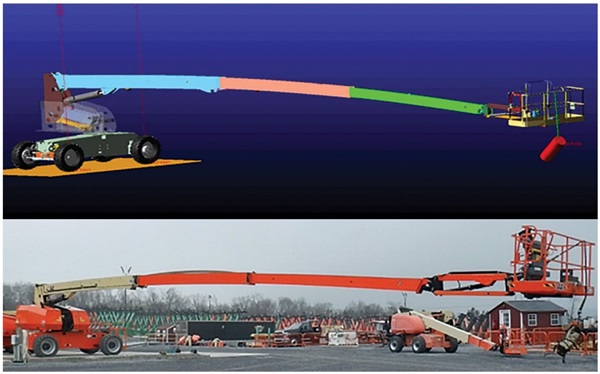Faster testing and virtual validation of access equipment with Adams Real Time
by Ian Hogg, Adams Product Manager, Hexagon’s Manufacturing Intelligence division

Engineering Reality 2023 volume 2 edition
Empowering Makers for an autonomous sustainable future
JLG leverages Adams and Adams RT to significantly reduce testing time and improve the design of its access equipment
JLG Industries is headquartered in McConnellsburg, Pennsylvania, USA and is one of the world’s leading designers and manufacturers of access equipment and mobile elevation platforms such as boom lifts, scissor lifts, vertical lifts, and telehandlers, used in construction, fit-outs, industrial maintenance, material handling and facilities maintenance. The company was founded in 1969 and was acquired by Oshkosh Corporation in 2006. JLG’s Global Product Development group (GPD) is responsible for designing all equipment, building prototypes, testing, and validation.
Muhammad Sannah, Sr. Chief Engineer, JLG, explains: “With the growing scale and complexity of access equipment, building and testing physical prototypes is very costly in terms of time and resources required, limiting innovation and design exploration of new types of systems. Part of the goal of the GPD team is to replicate as much of our physical testing into the virtual realm, which requires rapid and reliable simulation tools. Using Adams has not only allowed us to bring higher quality products to market more quickly – it has also opened new possibilities for us to design and simulate new types of systems, to study proposed concepts very quickly, and to validate new ideas.”

Figure 1. Mannequin drop Adams simulation (top) and physical test (bottom).
Reaping the benefits of Adams for over 28 years
JLG first started using Adams in 1995, to augment hand calculations they used to develop machines, linkages, and mechanisms. “Our usage of Adams has developed a lot over the last 28 years, and the benefits have scaled too,” said Muhammad. “Initially, we used it just for validation, but since we have built up our usage and trust in the tool, it is used in most of our design processes. We now use Adams to investigate advanced characteristics of a multitude of vehicle configurations and situations, to deliver more robust designs that account for real world conditions. In addition to saving us time, using Adams has given us a higher degree of reliability and confidence in our design.”
Bridging the gap between the virtual and real world
“Now, we can get an early gauge of test performance in minutes. Design changes that impact test performance can be evaluated virtually, so we have better insight into how the prototype will perform when the physical test is performed.”

Figure 2. Telehandler driving Adams simulation (top) and physical test (bottom).

Figure 3. JLG’s dSpace hardware.
JLG uses the dSPACE HiL system that connects to the physical control panel, and couples that to the ECU (Electric Control Unit) system and the Adams RT virtual equipment model, to improve validation speed and efficiency. “The full regression testing for our ECU used to take many hours,” says Justin Madsen, Chief Engineer, JLG. “In the past, we had to do this for every model and every ECU revision. Now, we are setting these up to run automatically in HiL. Testing time has come down by up to 90%, and we can even reduce the impact on our working hours by running that process overnight. The only upfront work is to set up the model and the tests, and, in fact, the models already exist!
We use the same model as we used to analyse dynamics events in Adams in Adams RT as part of our HiL process. Not only does this expedite the process, but it means we are sure we have the right fidelity in our model to match real world physics. We build one model that can be used in one environment for many different purposes, and the Variants tool in Adams helps us to build, maintain and share different versions of that model very easily.”
Reduced testing time while improving knowledge gained
Testing is a requirement for every model, and the benefits of recreating tests in the virtual domain are significant. “When we had to set up physical tests, a single test could take hours or days on a prototype,” explains Justin. “Now, we can get an early gauge of test performance in minutes. Design changes that impact test performance can be evaluated virtually, so we have better insight into how the prototype will perform when the physical test is performed. But the simulation is not only quicker and cheaper
than physical testing, it also gives us more information – we can keep varying the set-up, perform far more tests, and get margins of operation. Ultimately, this means we can more confidently specify the operating range of this equipment.”
Leveraging Hexagon products for improved, efficient workflows
In addition to using Adams, JLG has also been using MSC Nastran for structural analysis, and FEA packages Patran and MSC Apex to make its fatigue calculations easier
and more streamlined. The FE is brought into Adams by importing MNF (Modal Neutral File) files, and then dynamic strains and loads are calculated through a combination
of Adams and nCode. “We believe that Adams and MSC Nastran will remain very important parts of our process in the future, and in fact we intend to expand our usage of these products. We have also recently started using Actran for NVH – to predict noise outputs early in design. Finally, we are seeing a big push for electric applications –
we’d be keen to see how we can apply similar methods to these applications, and in particular how we can leverage Hexagon’s expertise in this area,” said Muhammad.